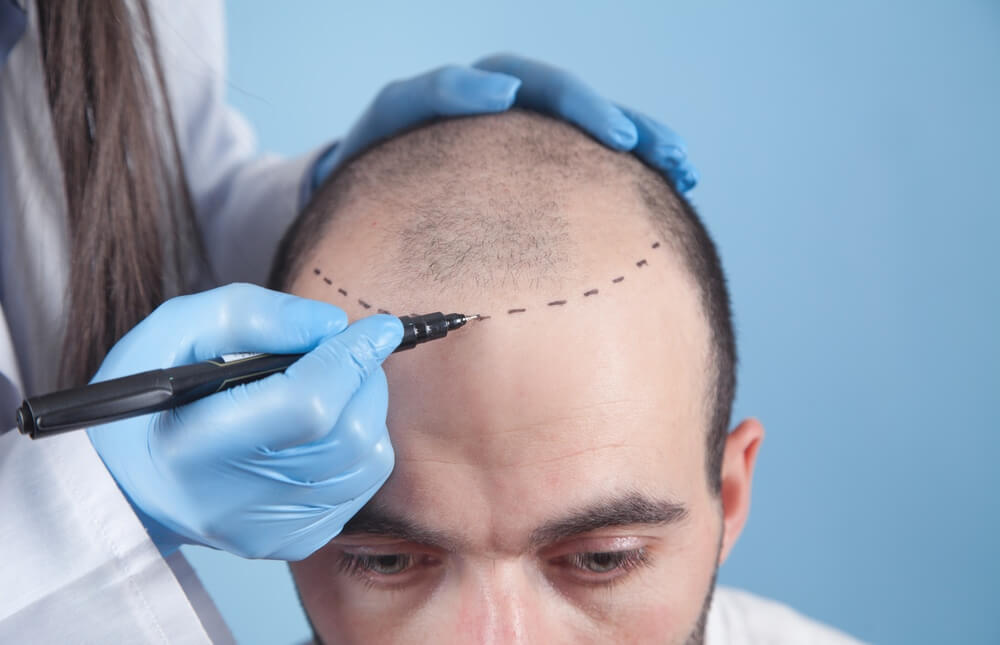
Hair loss is a condition that occurs due to genetics, hormonal changes and aging, and causes physical and psychological problems in both men and women. Hair loss can also occur due to various dermatological diseases, burns and traumatic reasons.
Nowadays, patients with hair loss can regain their young, natural appearance with hair transplantation. In addition, with hair transplantation, situations such as psychological disorders and social distancing in people suffering from hair loss are eliminated, and the person regains his youthful appearance and self-confidence after the hair transplantation operation.
Two different methods are generally used in hair transplantation, known as FUT and FUE. In the Follicular Unit Transplantation (FUT) technique, a piece of skin is surgically removed as a strip from the area where the healthy roots are located in the nape of the neck, between the two ears, and is first divided into individual roots. These roots are then placed into channels opened in the area where hair growth is desired. This method has now been completely abandoned due to the development and advantages of the FUE method. The technique called Follicular Unit Extraction (FUE) is based on the principle of collecting individual follicles, which allows the most efficient use of the donor area. This method has been applied since 2004. The only difference between the FUT method and the FUE method is the hair follicle extraction technique. Channel opening and placement stages are the same for both methods.
ADVANTAGES OF HAIR TRANSPLANT TECHNIQUE
2000-3500 hair follicles can be removed in each session.
Several sessions may be applied depending on the width of the area with hair loss.
There is no numbness or scarring in the donor area. Since the scalp strip is not removed from the nape area, healing is much faster.
Within a few days, the tiny holes in the area where the follicles were removed close without leaving a scar.
If the hair will be transplanted to the front hairline or the hair will be left very short, the results of the FUE method are superior. Because when the root part of the hair follicles taken with needles of 0.70 to 0.90 mm in diameter are very thin, it gives a more natural appearance in the transplanted area.
WHO CAN DO HAIR TRANSPLANT OPERATION?
Despite all its practicality, hair transplantation is a surgical intervention that must be performed by experienced plastic surgeons in environments where the necessary medical conditions are met.
AFTER THE OPERATION
The person can return home immediately after the hair transplantation procedure is completed. Hair is not washed for 4 days. At the end of this period, the transplanted area and the donor areas are washed and this process is repeated every day for 10 days until the donor area heals and the crusting on the recipient area disappears. Hair transplantation is a procedure that does not restrict daily activity. The patient can return to work by wearing a loose-fitting hat that will not come into contact with the transplanted area. The transplanted hair falls out after a while, and the hair that starts to grow approximately 3 months after transplantation begins to grow in its new place at the same growth rate as in its original place. Since the genetic codes and characteristics of these hairs are different, no shedding occurs in the transplanted hair.
HOW DOES THE OPERATION PERFORM?
Hair transplantation is performed under local anesthesia and is easily tolerated by patients. Before the operation begins, the areas where hair transplantation will be performed are marked. When making these drawings, it is very important that the area where the hair will be transplanted complies with the natural hair lines so that it does not create an artificial appearance. After the area is prepared and anesthetized with injections, the follicular units are removed one by one from the back and side parts of the scalp. A specially manufactured microsurgical motor and instruments with a diameter between 0.70 and 0.90 mm are used for the follicular unit extraction process. After the removal of the roots is completed, the transplantation process is started to the hairless area. After this area is anesthetized with local anesthetics, canals equal to the number of roots to be transplanted are opened with a fine-tipped scalpel. Prepared grafts (hair follicles) are placed one by one into these channels. The results to be achieved in hair transplantation are closely related to the use of the technique by an experienced team, meticulous adherence to surgical rules, careful selection of cases, informing the patients well before transplantation, and realistic expectations, as well as the condition and quality of the existing hair. The number of hair follicles taken from the area above the neck varies between 2000 and 3500, depending on the density of the person's hair in this area. Although the density of hair in the donor area is an important factor, a more important factor is the degree of openness in the front part of the person. In people with less open space, these hair follicles can be placed more frequently and more successful results can be obtained.

